
In this edition
- Season's Greetings
- Recent surveyor audit findings
- What is corrective action?
- Condition of tailshaft, survey recommended by Surveyor
- Stability audits – common findings
- Maintaining professional competence
- Marine Safety Incident – POB
- Harmonisation of shaft surveys with renewal surveys
- Initial survey of sister vessels
- Weld defects and NDT examination
- NSCV C6B review project commencing
- We welcome your feedback
Season's Greetings
The AMSA team would like to wish all our readers a Merry Christmas.
Tis the season to be jolly, to prosper, and to carry good tidings of this year into the next. Thank you for your partnership and for our valued relationship with you. May you and your family have a wonderful Christmas and may you experience great success this coming New Year. Merry Christmas to you and your family.
The DCV Applications team remain on deck to process temporary operation approvals lodged between Christmas and the New Year.
Recent surveyor audit findings
Since the last edition AMSA has conducted over 30 Accredited Marine Surveyor Audits, most of which covered several surveys.
Many audits were positive, with findings mainly observations or minor non-conformances, however four major non-conformances were issued.
Two major non-conformances were issued to one surveyor because stability books, substantially not meeting the requirements of the NSCV, had been approved. In one case this resulted in AMSA downgrading the previously issued Certificate of Survey. For the repeated breach, the accredited marine surveyor was issued a $2,664 infringement (fine), for not complying with the conditions of their accreditation.
A major non-conformance was issued because an accredited surveyor had completed and recommended a renewal survey for a class 1 vessel > 12 m, accepting the owner’s declaration for the lightship check (instead of a lightship measurement). The accredited marine surveyor implemented corrective actions to ensure the issue was rectified and ensure it would not occur again. A counselling letter for a breach of conditions of accreditation was issued.
A major non-conformance was issued because the requirements of NSCV C7A had been improperly applied during a survey, this resulted in a Class 2C vessel not being provided with a liferaft.
What is corrective action?
AMSA conducts regular audits of the survey records and recommendations made by Accredited Marine Surveyors (AMS). The purpose of these audits is to monitor the quality of the surveys conducted, ideally promoting, and assisting with continuous improvement.
AMSA categorise findings from audits as follows:
- Observations (these can be positive, neutral, or negative) - these are for the information of the AMS and require no response to be provided to AMSA.
- Minor non-conformances and Major non-conformances – these require a corrective action to be provided to AMSA.
What does a corrective action need to achieve?
A corrective action needs to:
- Correct any immediate issues, if required, to make the problem right; and
- Correct systemic issues (issues in your survey system), to prevent re-occurrence, for example by incorporating:
- lessons learnt; or
- improvements to survey techniques and procedures.
- The substance of the corrective action should be proportionate to the level of the Non-Conformity identified.
Examples
| Non-Conformity | Example of Corrective Action | Good or Bad? |
| Minor Non-Conformity – Form 638 for SHAFT survey does not indicate that a dimensional check was conducted and no supporting documentation supplied in this respect. | “Dimensional check was done; shafts are in good condition.” | Bad - No Immediate or Preventative Corrective Action |
| “Please find attached a revised form supplemented by copies of my field notes. Going forward more attention will be paid to providing the correct information in recommendations for shaft surveys, evidenced by supporting documentation, if required.” | Good – Correct Form supplied with supporting documentation and measures to prevent re-occurrence (lessons learnt). | |
| Major Non-Conformity – Temporary Operations Permit was issued to the vessel following Renewal Survey when major deficiencies remained not rectified. | “I’ve known this operator for years and he is very trustworthy. I had every confidence that he would rectify the items before operating, therefore I issued a Temporary Operations Permit with these items outstanding. There was no risk to safety. Everything has now been repaired and the vessel is in good condition. “ | Bad – No preventative corrective action |
| “I have followed up with the owner who confirms that all of the major deficiencies have now been rectified. I have reviewed Exemption 07 and now better understand the conditions under which I have the delegation to issue a Temporary Operations Permit. I have updated my survey procedures accordingly.” | Good – Immediate corrective Action (follow up) and Preventative Corrective Action (lessons learnt, procedures updated). |
The purpose of the audit process is to assist surveyors to identify areas of improvement in their survey process. AMSA and accredited surveyors must work together to build trust with customers, by improving the professionalism, accuracy and consistency of surveys conducted around Australia.
Condition of tailshaft, survey recommended by Surveyor
During the desktop audit of a periodic shaft survey recommended by an accredited surveyor it became apparent that the surveyor recommended a periodic shaft survey of a water lubricated shaft, in the condition shown below, for a 1C passenger vessel. Despite noticing significant surface corrosion/pitting and excessive wear on the shaft, the accredited marine surveyor recommended the shaft survey without performing adequate tests (e.g.: NDT, dimension/trueness check etc.) to determine the suitability of shaft for the next 5 years. AMSA seeks your view whether you would recommend shaft surveys for this tailshaft without performing any additional checks or remedial action.
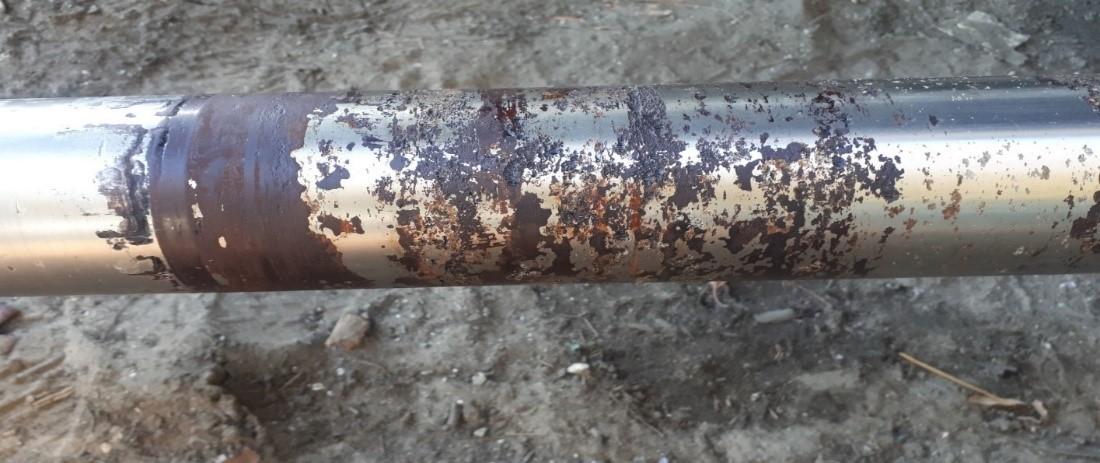
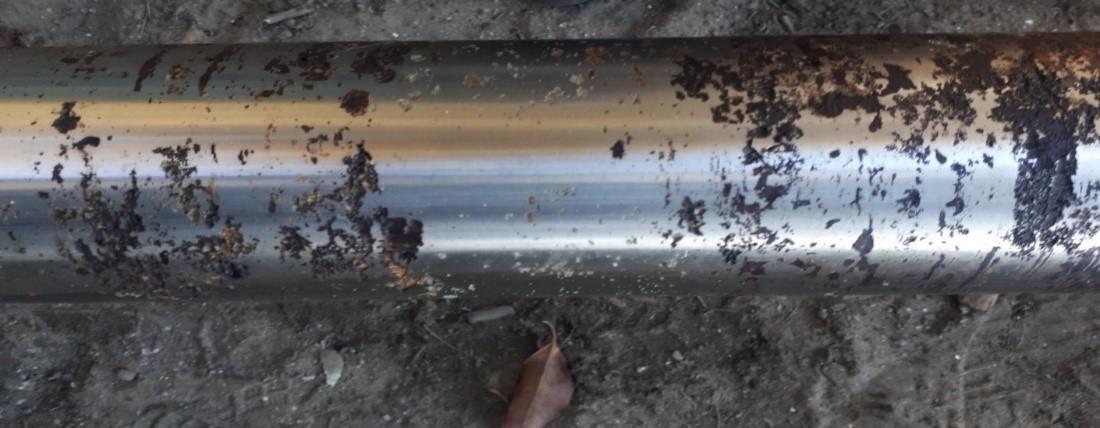
Stability audits – common findings
AMSA audits accredited marine surveyors to ensure the correct procedures and protocols set out in the National Law - Marine Surveyors Accreditation Guidance Manual (SAGM) and the Marine Safety (Domestic Commercial Vessel) National Law Regulation 2013 (the regulations) are being implemented.
AMSA has performed over 300 audits related to Stability approvals from accredited marine surveyors (AMS), with the assistance of Transport of New South Wales. Most of the submissions from accredited surveyors were found to be compliant and several positive observations noted. However, some of the audits identified several serious findings and the vessels failed to meet criteria. Below are some of the most common non-conformances identified:
1. Maximum allowable angle of Static Heel
In most cases, the AMS determined the heel consequence of the vessel as low and applied the allowable single and combined angles of static heel as 14 and 18 degrees respectively. However, during the audits, it was noted that several vessels did not meet the conditions of application of low heel consequence level. Several of these vessels failed to meet the comprehensive stability criteria for angle of heel when heel consequence of the vessel was determined as Moderate or High. AMSA encourages AMS approving Stability Booklets to ensure that the conditions of application for appropriate heel consequence level are met for each vessel. These conditions ensure that the vessel has adequate capacity to control the risks as the static heel angle increases. NSCV Part C Section 6 Subsection 6A Ch.3.8 Table-4, cited below, addresses these requirements:
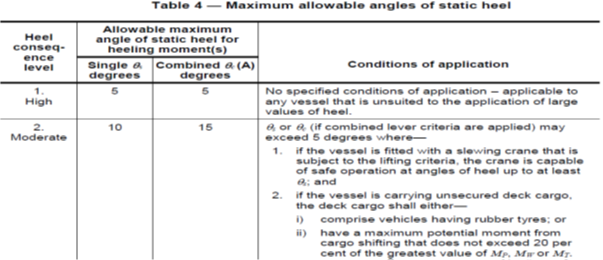
2. Allowable loss of freeboard calculation using alternate simplified criteria.
In several cases, the type of vessel (cockpit vessels and well deck vessels) was identified incorrectly by the surveyor, which leads to application of incorrect simplified stability criteria for calculation of the allowable loss of freeboard. In several cases, it was noted that the accredited surveyors used the allowable loss of freeboard criteria for cockpit vessels, instead of using well deck vessel criteria. AMSA identified, during the audits, that these vessels failed to meet the well deck criteria. Definition of the type of vessel can be found in NSCV Part C Section 6 Subsection 6A Ch.1.7 and Fig-2. The relevant simplified stability criteria for measurement of inclined freeboard can be found in NSCV Part C Section 6 Subsection 6A Ch.7.4.5. We have summarised the definition and requirements in the below table for the ease of reference.
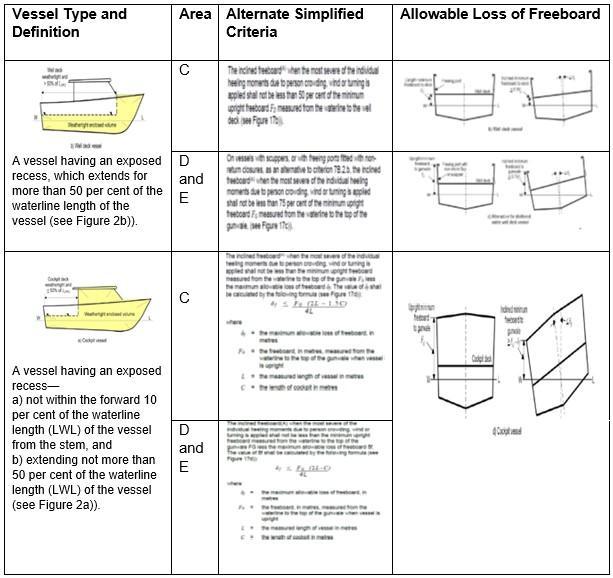
3. Wind pressures in bare poles condition for sailing yachts.
For sailing yachts, surveyors have applied wind speed restrictions for operations during bare poles to satisfy the criteria for wind heeling angles, in some cases. Surveyors should consider not applying a restriction in wind speed, while calculating the wind heeling moments in bare poles condition.
AMSA considers application of a restriction on wind speed as failing the criteria for wind heeling angles for the area of operation. The minimum wind pressure to be used in the wind heeling moment calculation is specified in NSCV Part C Section 6 Subsection 6A Annex B 3.1 Table 41, as cited below:

Maintaining professional competence
Section 28 of the Marine Safety (Domestic Commercial Vessel) National Law Regulation 2013 (the regulations) requires an accredited marine surveyor to maintain professional competence in the categories of surveying in which they are accredited.
AMSA expects an accredited surveyor to:
1. Maintain their professional competence in marine surveying.
As a guide AMSA generally expects every accredited surveyor to spend at least 45 hours over a 3-year period maintaining professional competence on items directly related to the role of a surveyor. The table below should be used as a guide.
2. Fulfill the Continuous Professional Development (CPD) requirements of their professional association, to maintain membership.
This varies from association to association and the scope can be broad. Associations would normally consider crediting professional competence items mentioned above against their CPD requirements. Associations typically require 105-150 hours of CPD over a 3-year period.
If an accredited surveyor takes a break from surveying, AMSA does not generally expect them to maintain their professional competence during this period. However, if an accredited surveyor re-commences surveying, AMSA expects them to be able to demonstrate they have spent a suitable amount of time fulfilling the requirements above and may request evidence that their professional competence is up to date.
If an accredited surveyor takes a break from surveying, AMSA does not generally expect them to maintain their professional competence during this period. However, if an accredited surveyor re-commences surveying, AMSA expects them to be able to demonstrate they have spent a suitable amount of time fulfilling the requirements above and may request evidence that their professional competence is up to date.
| Activity | Maximum number of hours to count per 3-year period | Examples |
| Keeping up to date with changes to the National Law and AMSA processes | 20 Hours (mandatory) | This includes the reading of ‘AMSA Survey Matters’, familiarisation with changes to SAGM, Marine Orders and Exemptions. |
| Workshops and technical meetings | 20 Hours | Technical meetings, including AMSA workshops and relevant professional association meetings. |
| Courses | 25 Hours | Tertiary or short courses in Law, Naval Architecture, Marine Engineering, Electrical Engineering, Fire, Risk Management, Working at Heights, Confined Space Entry. |
| Practical training | 15 Hours | Training with a more experienced AMS or an AMS with a different skill set. |
| Private study which extends relevant knowledge and skills. | 5 Hours | Private study includes the reading of books, journals, transactions, technical content on the internet etc. |
| Any other structured activities that meet the purpose maintaining professional competence. | Unlimited, but to be balanced with some other professional competence activities listed above. |
Marine Safety Incident – POB
A private charter cruise vessel had an incident when a guest with a toddler walking from aft deck to the swim platform fell overboard. The master had seen the guest with the toddler a few seconds earlier on the CCTV but no one saw them fall. A few seconds later the master noticed that the double gate was wide open and he could not see passengers on the swim platform. The persons overboard were spotted about 80-100m astern and before they could be reached, there were screams and yells from the toddler’s mother who jumped into the water to rescue. The POB were retrieved successfully and bought on board – shaken but no injuries.
Why this happened?
- The guest is assumed to have leant against the gate which opened under the pressure of his body weight.
- The double gate had not been properly secured shut with the locking bolt at some stage prior to departure.
- The gate was only held shut by a “flap” cover that did not fully prevent opening under pressure.
- The gate can open both inwards and outwards with no ‘stop’ preventer either way.
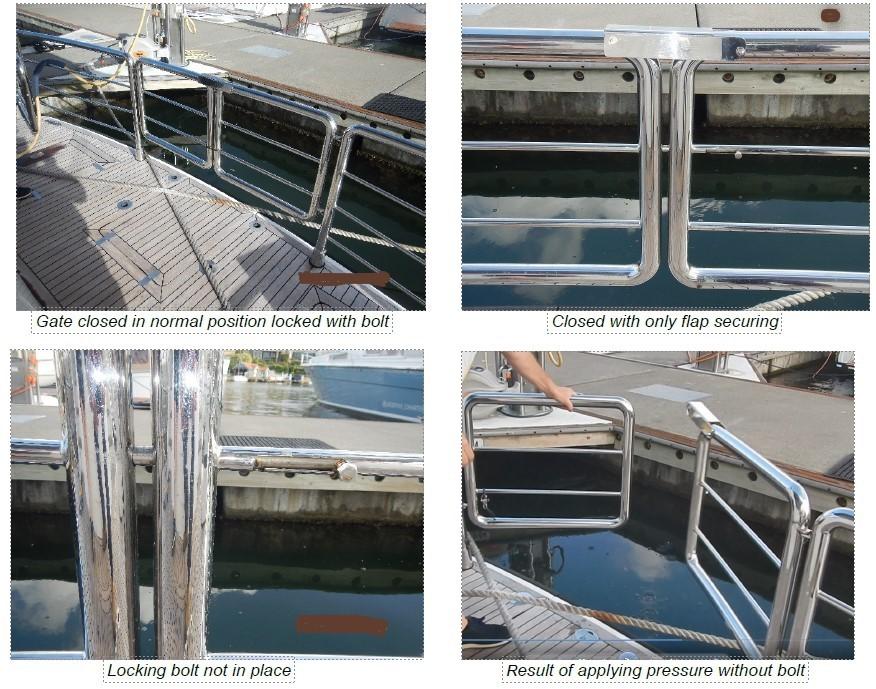
AMSA has conducted a review of the vessel’s safety management system and identified deficiencies relating to risk assessments and passenger verification procedure. The operator has engaged a fabricator to redesign gates and to prevent them from opening outwards.
Safe design is a better control than administrative measures such as the safety management system
It is requested that surveyors inspect the opening and gates in bulwarks and railings for securing devices and bring any safety concerns to the attention of the owner and Master.
Harmonisation of shaft surveys with renewal surveys
Sometimes owners voluntarily draw shafts outside a vessel’s renewal survey window, perhaps if there is an issue with the bearings/sealing arrangements or if the shafts require renewal.
The SAGM requires that shafts be withdrawn and a SHAFT Survey conducted as part of a renewal survey. If a shaft has been previously withdrawn, just outside the renewal survey window, owners can obviously be reluctant to do this again.
Therefore, if a SHAFT survey is done outside the Renewal Survey window the best option (as the vessel will be out of the water) is to conduct a full Renewal Survey early to set the vessel up for the next 5 year cycle.
If this is not possible, owners have the option to apply for a Specific Exemption (SPEX) to allow the likes of a new shaft to be exempt from the requirement to be withdrawn at the next Renewal Survey. Such exemptions would only be granted in exceptional circumstances. Factors considered would be the time between shaft surveys being requested, the age of the shaft, the number of shafts the vessel has, envisaged running hours, the type of shaft material used, the type of bearing lubrication, whether the vessel is left in the water for prolonged periods without the shaft turning, duration of repair facility (slip) availability etc...
Previous State Authority practices of allowing shafts to be withdrawn at periodic out of water surveys are no longer considered.
Initial survey of sister vessels
For AMSA to issue a certificate of survey, an application must be supported by the required survey reports and recommendations.
For the initial survey of a sister vessel, clause 3.9.5 of Part 2 of SAGM provides that, in lieu of full plan approval, the basis vessels approved plans are able to be submitted, and they need to be accompanied by a statement from an accredited marine surveyor with category ‘a’ (plan approval) accreditation (as per clause 3.9.1) as well as a lightship comparison report of the basis and sister vessel.
Depending on the type of sister vessel, the accompanying statement would need to confirm the basis and sister vessels’ service categories, crew, special personnel and passenger numbers, and maximum speeds.
Construction and commissioning phases of initial survey are to be conducted as per any other new vessel construction, in accordance with Part 2 of SAGM.
If you do not currently hold copies of the basis vessels plans and/or stability documentation, you may be able to request copies of the basis vessels records, however intellectual property considerations may apply.
Please see the AMSA website for instructions on how to request vessel records.
Weld defects and NDT examination
Weld defects may have serious consequences if not identified and properly repaired. Different types of weld defects cause different effects on the ships structure.
Cracks, lack of fusion and incomplete joint penetration can create notch effects. Discontinuities such porosity and slag inclusions amplify stresses by reducing the weld area.
Cracks – are the most serious type of welding defect because of their tendency to propagate under certain levels of stresses. They are the primary cause of structural failure. Cracks act as stress concentrators and are not acceptable for ship hull welds, regardless of their size. They must be repaired immediately.
Lack of fusion – is a failure of the welding process, fusion failed to occur between the base metal and the weld metal, caused by improper welding techniques, preparation of the material for welding, incorrect joint design.
Lack of penetration – This is a root condition in which the weld bead does not penetrate the entire thickness of the base plate or when two opposing beads do not interpenetrate. This will cause weld failure if the weld is subjected to tension or bending stresses.
Undercut is a groove melted into the base metal adjacent to the weld toe or weld root and left unfilled by weld metal. Concavity is a weld discontinuity in which the maximum distance from the face of a concave weld perpendicular to a line joining the weld toes is insufficient.
Inclusions are entrapped foreign solid material, such as slag, flux, or oxide.
Porosity occurs because of weld metal contamination. Gas is entrapped in solidifying weld metal. It is generally spherical but may also be elongated. Excessive hydrogen is one of the main causes of porosity and moisture is a major source of hydrogen.
Overlap - is an excess of weld metal covering the parent metal but not fused to it. Incorrect welding procedures, inappropriate selection of welding material, insufficient travel speed are some of the typical causes of overlap. This is one of the serious welding defects on ships and should be avoided.
Misalignment occurs in plates in the perpendicular direction to the plate surface and weld axis.
The non destructive test (NDT) methods used for detection of weld surface imperfections are visual testing, liquid penetrant testing and magnetic particle testing.
Ultrasonic testing and radiographic testing are NDT methods used for weld internal imperfections.
The acceptance criteria, defined by recognised organization or Australian Standards, can be used for the assessment of the results of different NDT methods.
For more information on welding inspection refer to instruction to surveyors DCV-ITS08.
NSCV C6B review project commencing
AMSA has commenced a review of NSCV C6B (Stability and buoyancy after flooding). The project seeks to make amendments to NSCV C6B based on issues and feedback supplied by accredited marine surveyors.
Specifically, the project will:
- review and validate the flotation and foam requirements of Annex C, D and F
- develop a new alternative simplified level flotation annex for low complexity vessels
- review and validate the raking damaged requirements for inflated collar vessels
- review the number of watertight doors per hull and the type of door
- develop guidance to assist with implementation and compliance
AMSA will be developing a Technical Advisory Panel (TAP) for this project. Interested industry stakeholders should complete the TAP nomination form available on the We welcome your feedback
Is there a topic you’d like to see covered in a future edition of Survey Matters? Send an email to DCVSurvey@amsa.gov.au with any suggestions or feedback.